Computer Vision Project: Face Recognition Attendance System
VerifiedAdded on 2023/02/01
|8
|2034
|64
Project
AI Summary
This project report details the design and implementation of a smart attendance monitoring system using face recognition techniques. The primary aim is to automate attendance, reduce errors, and improve efficiency in educational settings. The project's objectives include developing and evaluating an automated attendance system, as well as implementing a system for student identification through face recognition. The scope of the project encompasses the development of a non-intrusive camera-based system that scans classrooms, detects faces, and compares them with a stored database. The research addresses questions about the fundamental concepts of face recognition, its application in attendance control, and the required hardware and software. The methodology involves a qualitative research design, employing secondary data collection from various sources, including journal papers and online resources. Data analysis utilizes a content analysis approach, with APIs and face recognition algorithms used for real-time face detection. The project aims to provide a practical and effective solution for managing student attendance, offering a detailed analysis of the system's components and functionality.

Smart attendance monitoring system using
face recognition
face recognition
Secure Best Marks with AI Grader
Need help grading? Try our AI Grader for instant feedback on your assignments.
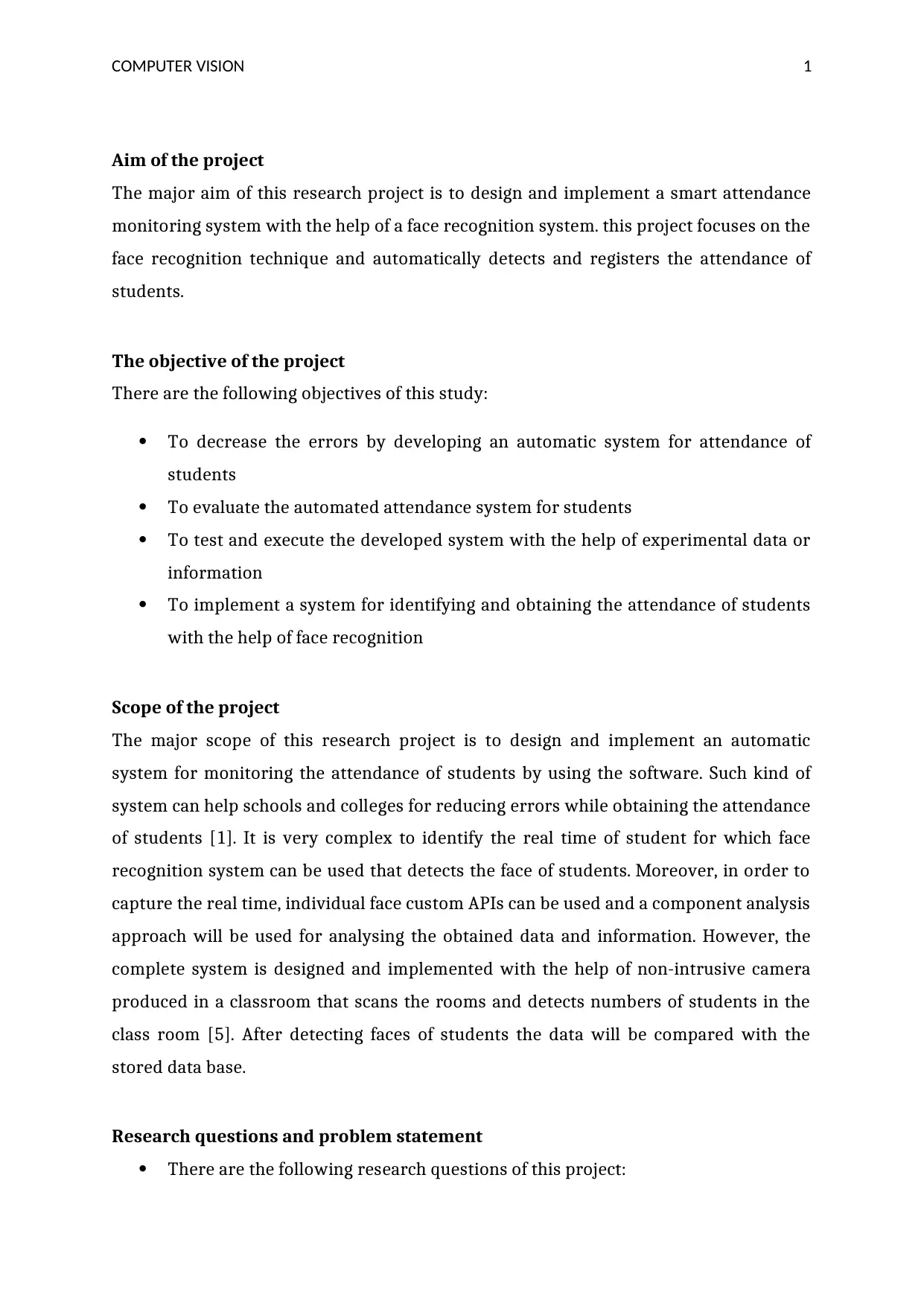
COMPUTER VISION 1
Aim of the project
The major aim of this research project is to design and implement a smart attendance
monitoring system with the help of a face recognition system. this project focuses on the
face recognition technique and automatically detects and registers the attendance of
students.
The objective of the project
There are the following objectives of this study:
To decrease the errors by developing an automatic system for attendance of
students
To evaluate the automated attendance system for students
To test and execute the developed system with the help of experimental data or
information
To implement a system for identifying and obtaining the attendance of students
with the help of face recognition
Scope of the project
The major scope of this research project is to design and implement an automatic
system for monitoring the attendance of students by using the software. Such kind of
system can help schools and colleges for reducing errors while obtaining the attendance
of students [1]. It is very complex to identify the real time of student for which face
recognition system can be used that detects the face of students. Moreover, in order to
capture the real time, individual face custom APIs can be used and a component analysis
approach will be used for analysing the obtained data and information. However, the
complete system is designed and implemented with the help of non-intrusive camera
produced in a classroom that scans the rooms and detects numbers of students in the
class room [5]. After detecting faces of students the data will be compared with the
stored data base.
Research questions and problem statement
There are the following research questions of this project:
Aim of the project
The major aim of this research project is to design and implement a smart attendance
monitoring system with the help of a face recognition system. this project focuses on the
face recognition technique and automatically detects and registers the attendance of
students.
The objective of the project
There are the following objectives of this study:
To decrease the errors by developing an automatic system for attendance of
students
To evaluate the automated attendance system for students
To test and execute the developed system with the help of experimental data or
information
To implement a system for identifying and obtaining the attendance of students
with the help of face recognition
Scope of the project
The major scope of this research project is to design and implement an automatic
system for monitoring the attendance of students by using the software. Such kind of
system can help schools and colleges for reducing errors while obtaining the attendance
of students [1]. It is very complex to identify the real time of student for which face
recognition system can be used that detects the face of students. Moreover, in order to
capture the real time, individual face custom APIs can be used and a component analysis
approach will be used for analysing the obtained data and information. However, the
complete system is designed and implemented with the help of non-intrusive camera
produced in a classroom that scans the rooms and detects numbers of students in the
class room [5]. After detecting faces of students the data will be compared with the
stored data base.
Research questions and problem statement
There are the following research questions of this project:
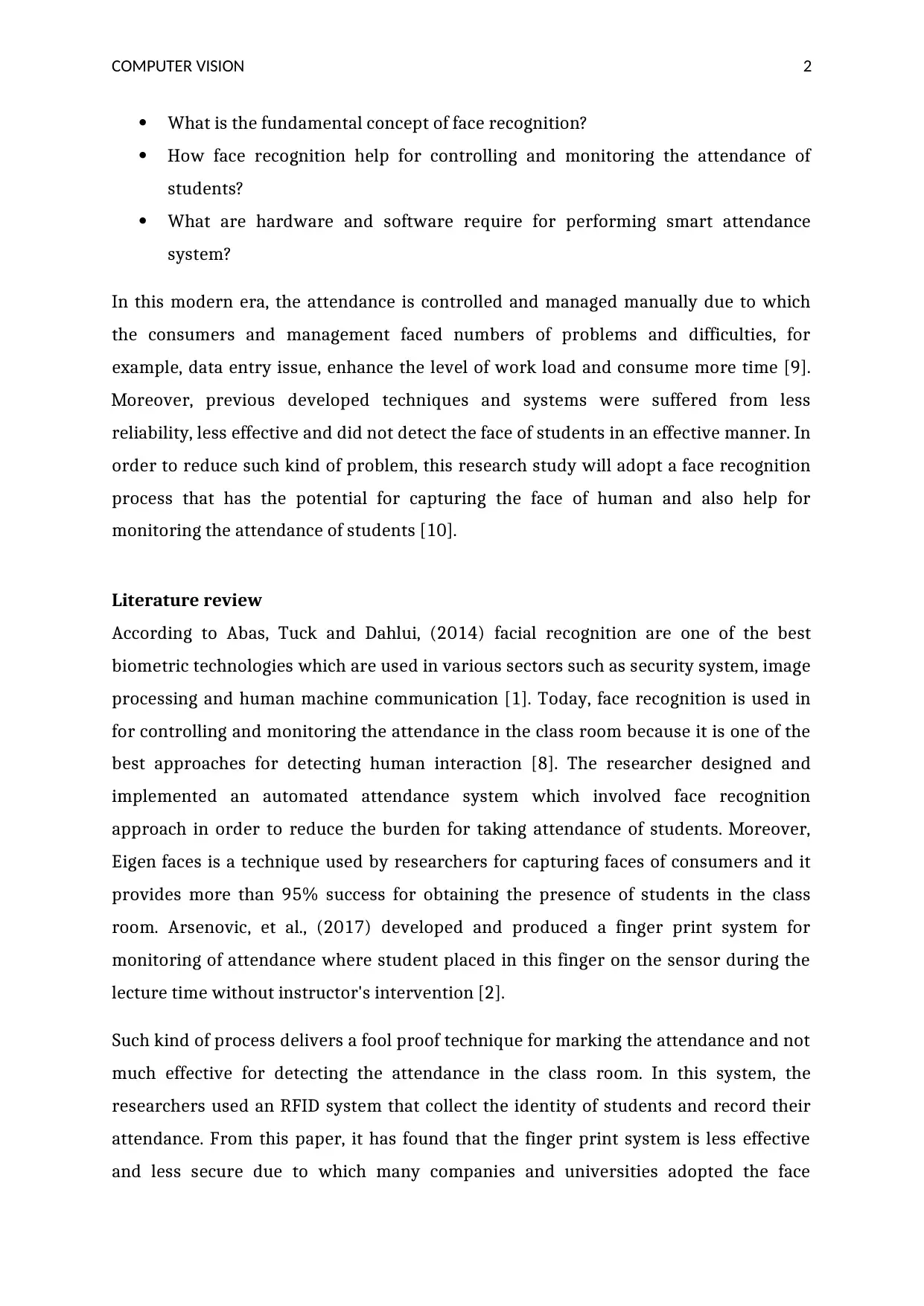
COMPUTER VISION 2
What is the fundamental concept of face recognition?
How face recognition help for controlling and monitoring the attendance of
students?
What are hardware and software require for performing smart attendance
system?
In this modern era, the attendance is controlled and managed manually due to which
the consumers and management faced numbers of problems and difficulties, for
example, data entry issue, enhance the level of work load and consume more time [9].
Moreover, previous developed techniques and systems were suffered from less
reliability, less effective and did not detect the face of students in an effective manner. In
order to reduce such kind of problem, this research study will adopt a face recognition
process that has the potential for capturing the face of human and also help for
monitoring the attendance of students [10].
Literature review
According to Abas, Tuck and Dahlui, (2014) facial recognition are one of the best
biometric technologies which are used in various sectors such as security system, image
processing and human machine communication [1]. Today, face recognition is used in
for controlling and monitoring the attendance in the class room because it is one of the
best approaches for detecting human interaction [8]. The researcher designed and
implemented an automated attendance system which involved face recognition
approach in order to reduce the burden for taking attendance of students. Moreover,
Eigen faces is a technique used by researchers for capturing faces of consumers and it
provides more than 95% success for obtaining the presence of students in the class
room. Arsenovic, et al., (2017) developed and produced a finger print system for
monitoring of attendance where student placed in this finger on the sensor during the
lecture time without instructor's intervention [2].
Such kind of process delivers a fool proof technique for marking the attendance and not
much effective for detecting the attendance in the class room. In this system, the
researchers used an RFID system that collect the identity of students and record their
attendance. From this paper, it has found that the finger print system is less effective
and less secure due to which many companies and universities adopted the face
What is the fundamental concept of face recognition?
How face recognition help for controlling and monitoring the attendance of
students?
What are hardware and software require for performing smart attendance
system?
In this modern era, the attendance is controlled and managed manually due to which
the consumers and management faced numbers of problems and difficulties, for
example, data entry issue, enhance the level of work load and consume more time [9].
Moreover, previous developed techniques and systems were suffered from less
reliability, less effective and did not detect the face of students in an effective manner. In
order to reduce such kind of problem, this research study will adopt a face recognition
process that has the potential for capturing the face of human and also help for
monitoring the attendance of students [10].
Literature review
According to Abas, Tuck and Dahlui, (2014) facial recognition are one of the best
biometric technologies which are used in various sectors such as security system, image
processing and human machine communication [1]. Today, face recognition is used in
for controlling and monitoring the attendance in the class room because it is one of the
best approaches for detecting human interaction [8]. The researcher designed and
implemented an automated attendance system which involved face recognition
approach in order to reduce the burden for taking attendance of students. Moreover,
Eigen faces is a technique used by researchers for capturing faces of consumers and it
provides more than 95% success for obtaining the presence of students in the class
room. Arsenovic, et al., (2017) developed and produced a finger print system for
monitoring of attendance where student placed in this finger on the sensor during the
lecture time without instructor's intervention [2].
Such kind of process delivers a fool proof technique for marking the attendance and not
much effective for detecting the attendance in the class room. In this system, the
researchers used an RFID system that collect the identity of students and record their
attendance. From this paper, it has found that the finger print system is less effective
and less secure due to which many companies and universities adopted the face
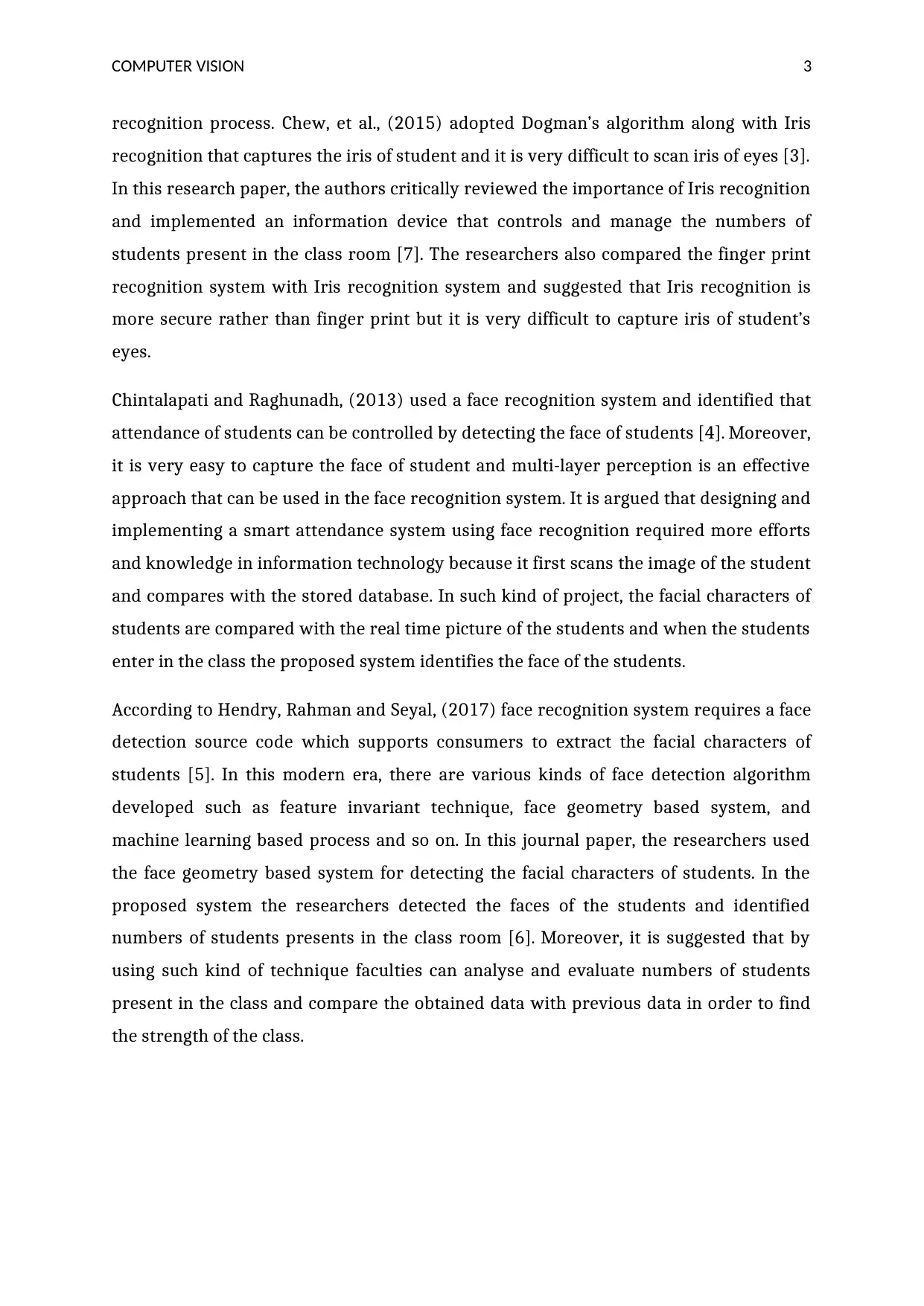
COMPUTER VISION 3
recognition process. Chew, et al., (2015) adopted Dogman’s algorithm along with Iris
recognition that captures the iris of student and it is very difficult to scan iris of eyes [3].
In this research paper, the authors critically reviewed the importance of Iris recognition
and implemented an information device that controls and manage the numbers of
students present in the class room [7]. The researchers also compared the finger print
recognition system with Iris recognition system and suggested that Iris recognition is
more secure rather than finger print but it is very difficult to capture iris of student’s
eyes.
Chintalapati and Raghunadh, (2013) used a face recognition system and identified that
attendance of students can be controlled by detecting the face of students [4]. Moreover,
it is very easy to capture the face of student and multi-layer perception is an effective
approach that can be used in the face recognition system. It is argued that designing and
implementing a smart attendance system using face recognition required more efforts
and knowledge in information technology because it first scans the image of the student
and compares with the stored database. In such kind of project, the facial characters of
students are compared with the real time picture of the students and when the students
enter in the class the proposed system identifies the face of the students.
According to Hendry, Rahman and Seyal, (2017) face recognition system requires a face
detection source code which supports consumers to extract the facial characters of
students [5]. In this modern era, there are various kinds of face detection algorithm
developed such as feature invariant technique, face geometry based system, and
machine learning based process and so on. In this journal paper, the researchers used
the face geometry based system for detecting the facial characters of students. In the
proposed system the researchers detected the faces of the students and identified
numbers of students presents in the class room [6]. Moreover, it is suggested that by
using such kind of technique faculties can analyse and evaluate numbers of students
present in the class and compare the obtained data with previous data in order to find
the strength of the class.
recognition process. Chew, et al., (2015) adopted Dogman’s algorithm along with Iris
recognition that captures the iris of student and it is very difficult to scan iris of eyes [3].
In this research paper, the authors critically reviewed the importance of Iris recognition
and implemented an information device that controls and manage the numbers of
students present in the class room [7]. The researchers also compared the finger print
recognition system with Iris recognition system and suggested that Iris recognition is
more secure rather than finger print but it is very difficult to capture iris of student’s
eyes.
Chintalapati and Raghunadh, (2013) used a face recognition system and identified that
attendance of students can be controlled by detecting the face of students [4]. Moreover,
it is very easy to capture the face of student and multi-layer perception is an effective
approach that can be used in the face recognition system. It is argued that designing and
implementing a smart attendance system using face recognition required more efforts
and knowledge in information technology because it first scans the image of the student
and compares with the stored database. In such kind of project, the facial characters of
students are compared with the real time picture of the students and when the students
enter in the class the proposed system identifies the face of the students.
According to Hendry, Rahman and Seyal, (2017) face recognition system requires a face
detection source code which supports consumers to extract the facial characters of
students [5]. In this modern era, there are various kinds of face detection algorithm
developed such as feature invariant technique, face geometry based system, and
machine learning based process and so on. In this journal paper, the researchers used
the face geometry based system for detecting the facial characters of students. In the
proposed system the researchers detected the faces of the students and identified
numbers of students presents in the class room [6]. Moreover, it is suggested that by
using such kind of technique faculties can analyse and evaluate numbers of students
present in the class and compare the obtained data with previous data in order to find
the strength of the class.
Secure Best Marks with AI Grader
Need help grading? Try our AI Grader for instant feedback on your assignments.
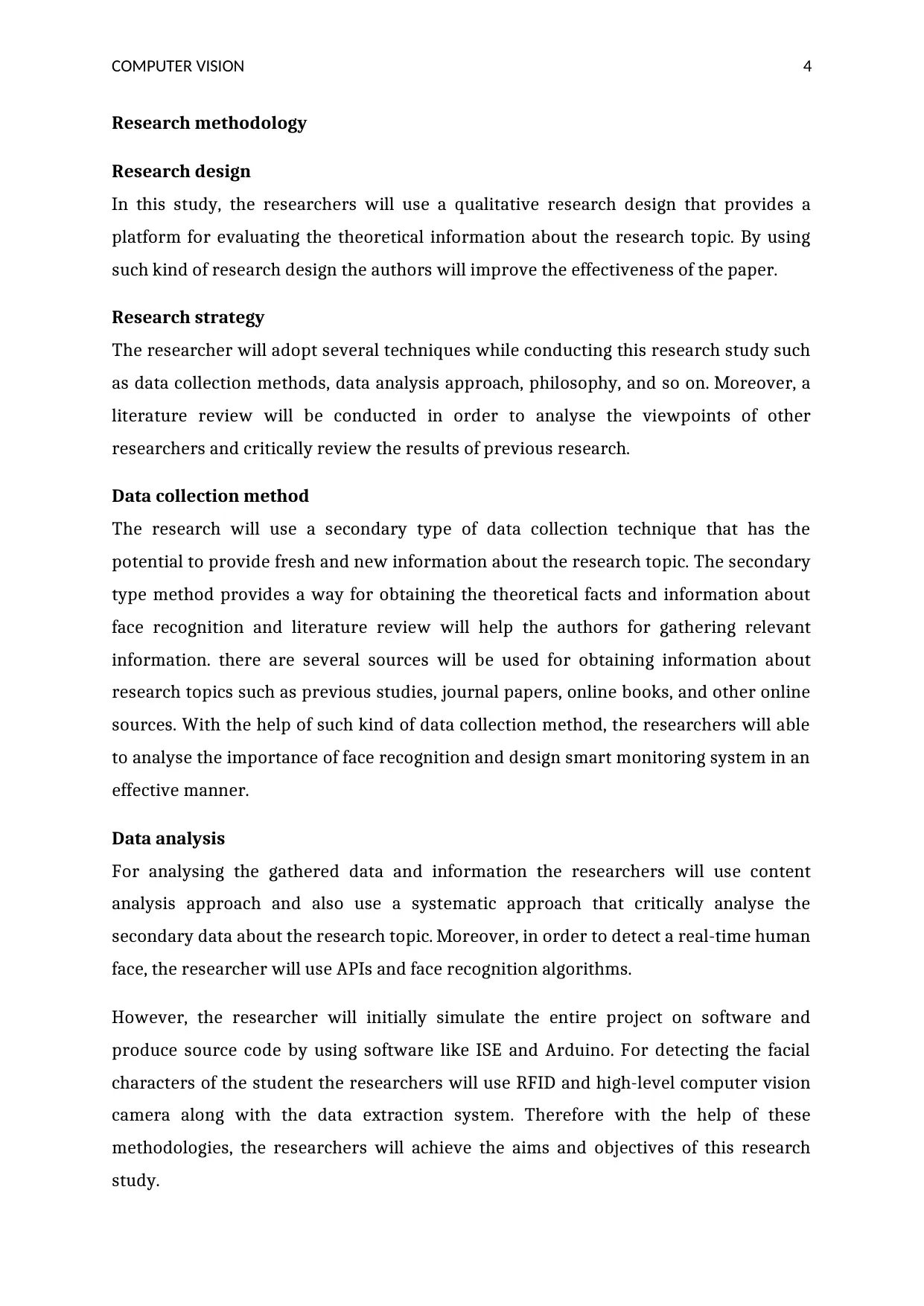
COMPUTER VISION 4
Research methodology
Research design
In this study, the researchers will use a qualitative research design that provides a
platform for evaluating the theoretical information about the research topic. By using
such kind of research design the authors will improve the effectiveness of the paper.
Research strategy
The researcher will adopt several techniques while conducting this research study such
as data collection methods, data analysis approach, philosophy, and so on. Moreover, a
literature review will be conducted in order to analyse the viewpoints of other
researchers and critically review the results of previous research.
Data collection method
The research will use a secondary type of data collection technique that has the
potential to provide fresh and new information about the research topic. The secondary
type method provides a way for obtaining the theoretical facts and information about
face recognition and literature review will help the authors for gathering relevant
information. there are several sources will be used for obtaining information about
research topics such as previous studies, journal papers, online books, and other online
sources. With the help of such kind of data collection method, the researchers will able
to analyse the importance of face recognition and design smart monitoring system in an
effective manner.
Data analysis
For analysing the gathered data and information the researchers will use content
analysis approach and also use a systematic approach that critically analyse the
secondary data about the research topic. Moreover, in order to detect a real-time human
face, the researcher will use APIs and face recognition algorithms.
However, the researcher will initially simulate the entire project on software and
produce source code by using software like ISE and Arduino. For detecting the facial
characters of the student the researchers will use RFID and high-level computer vision
camera along with the data extraction system. Therefore with the help of these
methodologies, the researchers will achieve the aims and objectives of this research
study.
Research methodology
Research design
In this study, the researchers will use a qualitative research design that provides a
platform for evaluating the theoretical information about the research topic. By using
such kind of research design the authors will improve the effectiveness of the paper.
Research strategy
The researcher will adopt several techniques while conducting this research study such
as data collection methods, data analysis approach, philosophy, and so on. Moreover, a
literature review will be conducted in order to analyse the viewpoints of other
researchers and critically review the results of previous research.
Data collection method
The research will use a secondary type of data collection technique that has the
potential to provide fresh and new information about the research topic. The secondary
type method provides a way for obtaining the theoretical facts and information about
face recognition and literature review will help the authors for gathering relevant
information. there are several sources will be used for obtaining information about
research topics such as previous studies, journal papers, online books, and other online
sources. With the help of such kind of data collection method, the researchers will able
to analyse the importance of face recognition and design smart monitoring system in an
effective manner.
Data analysis
For analysing the gathered data and information the researchers will use content
analysis approach and also use a systematic approach that critically analyse the
secondary data about the research topic. Moreover, in order to detect a real-time human
face, the researcher will use APIs and face recognition algorithms.
However, the researcher will initially simulate the entire project on software and
produce source code by using software like ISE and Arduino. For detecting the facial
characters of the student the researchers will use RFID and high-level computer vision
camera along with the data extraction system. Therefore with the help of these
methodologies, the researchers will achieve the aims and objectives of this research
study.

COMPUTER VISION 5
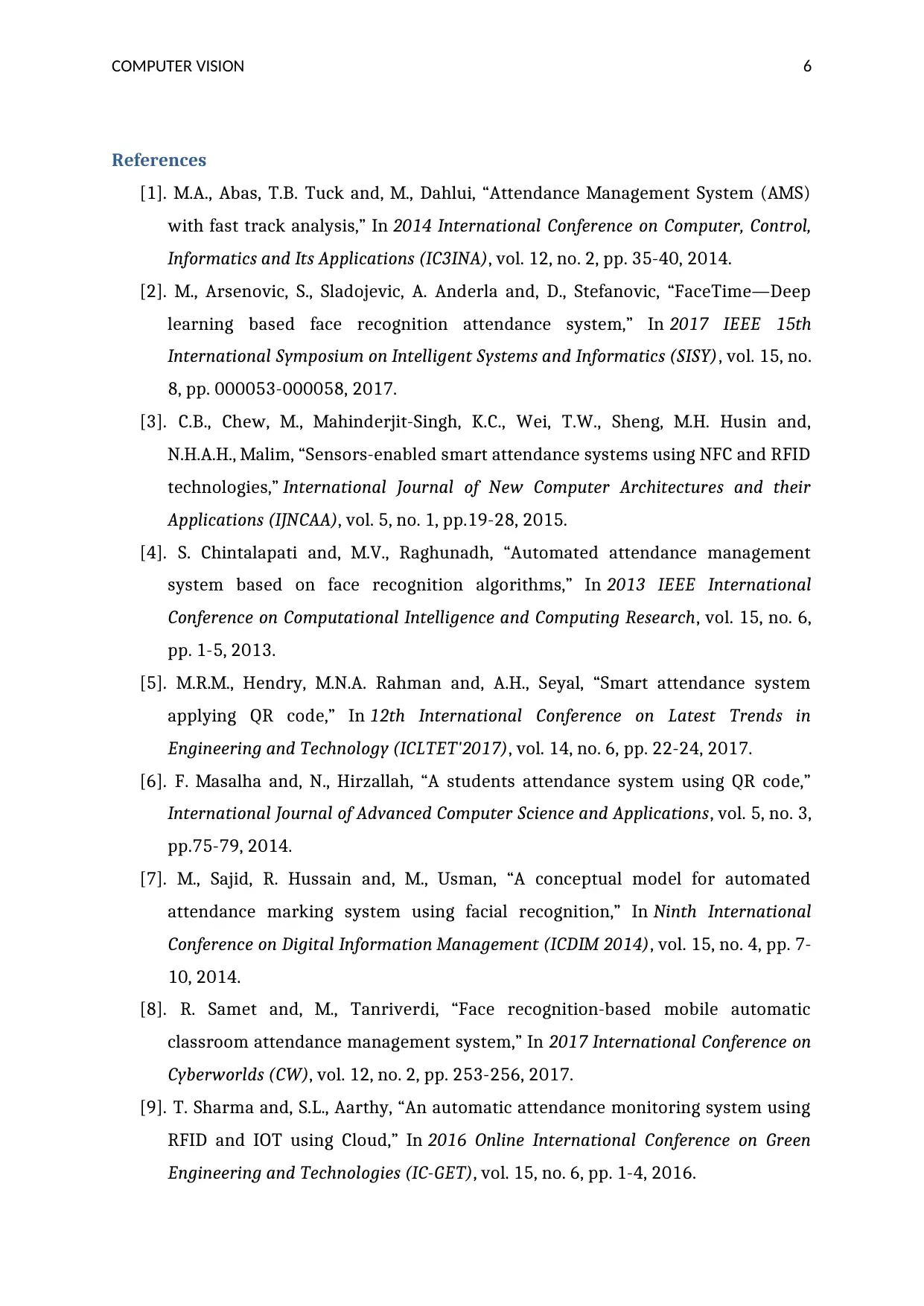
COMPUTER VISION 6
References
[1]. M.A., Abas, T.B. Tuck and, M., Dahlui, “Attendance Management System (AMS)
with fast track analysis,” In 2014 International Conference on Computer, Control,
Informatics and Its Applications (IC3INA), vol. 12, no. 2, pp. 35-40, 2014.
[2]. M., Arsenovic, S., Sladojevic, A. Anderla and, D., Stefanovic, “FaceTime—Deep
learning based face recognition attendance system,” In 2017 IEEE 15th
International Symposium on Intelligent Systems and Informatics (SISY), vol. 15, no.
8, pp. 000053-000058, 2017.
[3]. C.B., Chew, M., Mahinderjit-Singh, K.C., Wei, T.W., Sheng, M.H. Husin and,
N.H.A.H., Malim, “Sensors-enabled smart attendance systems using NFC and RFID
technologies,” International Journal of New Computer Architectures and their
Applications (IJNCAA), vol. 5, no. 1, pp.19-28, 2015.
[4]. S. Chintalapati and, M.V., Raghunadh, “Automated attendance management
system based on face recognition algorithms,” In 2013 IEEE International
Conference on Computational Intelligence and Computing Research, vol. 15, no. 6,
pp. 1-5, 2013.
[5]. M.R.M., Hendry, M.N.A. Rahman and, A.H., Seyal, “Smart attendance system
applying QR code,” In 12th International Conference on Latest Trends in
Engineering and Technology (ICLTET'2017), vol. 14, no. 6, pp. 22-24, 2017.
[6]. F. Masalha and, N., Hirzallah, “A students attendance system using QR code,”
International Journal of Advanced Computer Science and Applications, vol. 5, no. 3,
pp.75-79, 2014.
[7]. M., Sajid, R. Hussain and, M., Usman, “A conceptual model for automated
attendance marking system using facial recognition,” In Ninth International
Conference on Digital Information Management (ICDIM 2014), vol. 15, no. 4, pp. 7-
10, 2014.
[8]. R. Samet and, M., Tanriverdi, “Face recognition-based mobile automatic
classroom attendance management system,” In 2017 International Conference on
Cyberworlds (CW), vol. 12, no. 2, pp. 253-256, 2017.
[9]. T. Sharma and, S.L., Aarthy, “An automatic attendance monitoring system using
RFID and IOT using Cloud,” In 2016 Online International Conference on Green
Engineering and Technologies (IC-GET), vol. 15, no. 6, pp. 1-4, 2016.
References
[1]. M.A., Abas, T.B. Tuck and, M., Dahlui, “Attendance Management System (AMS)
with fast track analysis,” In 2014 International Conference on Computer, Control,
Informatics and Its Applications (IC3INA), vol. 12, no. 2, pp. 35-40, 2014.
[2]. M., Arsenovic, S., Sladojevic, A. Anderla and, D., Stefanovic, “FaceTime—Deep
learning based face recognition attendance system,” In 2017 IEEE 15th
International Symposium on Intelligent Systems and Informatics (SISY), vol. 15, no.
8, pp. 000053-000058, 2017.
[3]. C.B., Chew, M., Mahinderjit-Singh, K.C., Wei, T.W., Sheng, M.H. Husin and,
N.H.A.H., Malim, “Sensors-enabled smart attendance systems using NFC and RFID
technologies,” International Journal of New Computer Architectures and their
Applications (IJNCAA), vol. 5, no. 1, pp.19-28, 2015.
[4]. S. Chintalapati and, M.V., Raghunadh, “Automated attendance management
system based on face recognition algorithms,” In 2013 IEEE International
Conference on Computational Intelligence and Computing Research, vol. 15, no. 6,
pp. 1-5, 2013.
[5]. M.R.M., Hendry, M.N.A. Rahman and, A.H., Seyal, “Smart attendance system
applying QR code,” In 12th International Conference on Latest Trends in
Engineering and Technology (ICLTET'2017), vol. 14, no. 6, pp. 22-24, 2017.
[6]. F. Masalha and, N., Hirzallah, “A students attendance system using QR code,”
International Journal of Advanced Computer Science and Applications, vol. 5, no. 3,
pp.75-79, 2014.
[7]. M., Sajid, R. Hussain and, M., Usman, “A conceptual model for automated
attendance marking system using facial recognition,” In Ninth International
Conference on Digital Information Management (ICDIM 2014), vol. 15, no. 4, pp. 7-
10, 2014.
[8]. R. Samet and, M., Tanriverdi, “Face recognition-based mobile automatic
classroom attendance management system,” In 2017 International Conference on
Cyberworlds (CW), vol. 12, no. 2, pp. 253-256, 2017.
[9]. T. Sharma and, S.L., Aarthy, “An automatic attendance monitoring system using
RFID and IOT using Cloud,” In 2016 Online International Conference on Green
Engineering and Technologies (IC-GET), vol. 15, no. 6, pp. 1-4, 2016.
Paraphrase This Document
Need a fresh take? Get an instant paraphrase of this document with our AI Paraphraser

COMPUTER VISION 7
[10]. B., Surekha, K.J., Nazare, S.V. Raju and, N., Dey, “Attendance recording
system using partial face recognition algorithm,” In Intelligent techniques in
signal processing for multimedia security, vol. 10, no. 7, pp. 293-319, 2017.
[10]. B., Surekha, K.J., Nazare, S.V. Raju and, N., Dey, “Attendance recording
system using partial face recognition algorithm,” In Intelligent techniques in
signal processing for multimedia security, vol. 10, no. 7, pp. 293-319, 2017.
1 out of 8
Related Documents
Your All-in-One AI-Powered Toolkit for Academic Success.
+13062052269
info@desklib.com
Available 24*7 on WhatsApp / Email
![[object Object]](/_next/static/media/star-bottom.7253800d.svg)
Unlock your academic potential
© 2024 | Zucol Services PVT LTD | All rights reserved.





